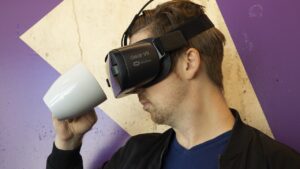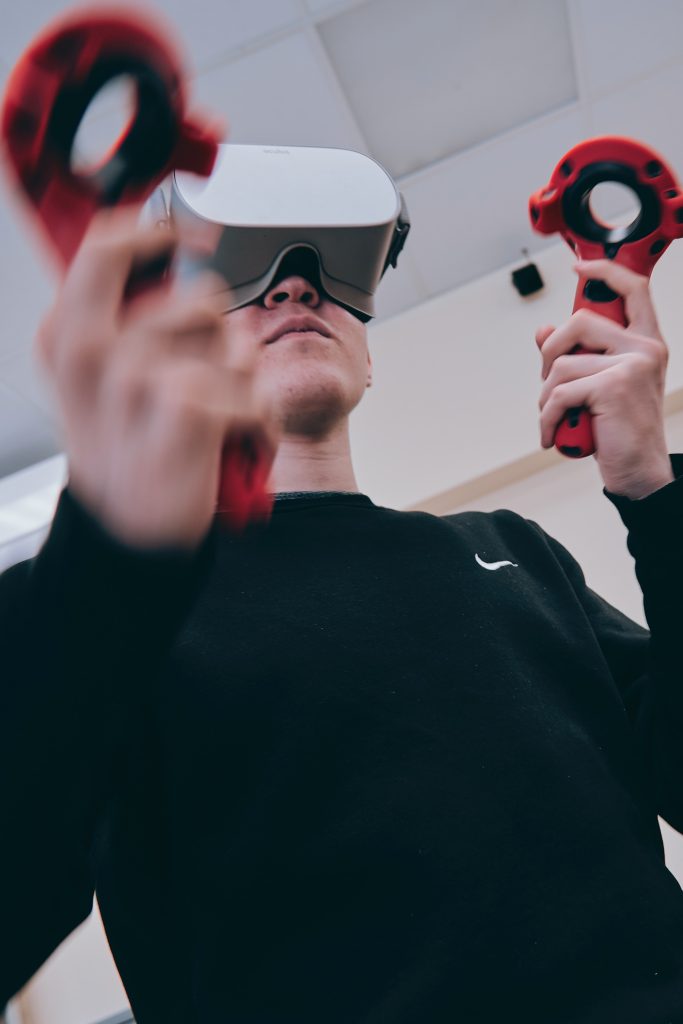Nearly four in ten Americans (38%) have used telehealth services to meet with a medical or mental health professional, according to one 2021 national public opinion poll of U.S. adults by the American Psychiatric Association (APA). While many continue to take care of their mental health via online services in a post-pandemic world, however, the use of technology in the form of virtual reality (VR) paints a colorful picture of what the future of mental health care could look like. From the first study to recent innovations and the concept’s efficacy, here’s what you should know regarding the potential future for VR and mental health.
The Role of VR in Therapy
Regarding mental health and technology, it’s important to note that most of our current digital health experiences are ‘two-dimensional,’ as pointed out by one Healthcare IT News interview with Risa Weisberg, chief clinical officer at mental health technology vendor BehaVR, a licensed clinical psychologist and an expert in cognitive behavioral therapy.
“Virtual reality replaces your sensory input, creating an immersive experience that the brain processes more like a completely new reality.” As a result, it’s explained that an individual’s experiences in VR are processed by the brain “in much the same way that actual experiences are.”
It’s worth mentioning that VR and mental healthcare is nothing new, highlights one post from the Smithsonian Magazine.
The first controlled study using VR to treat a psychological disorder was published in the American Journal of Psychiatry in 1995. The study involved using the technology to address the fear of heights, allowing Chris Klock, a junior at Georgia Tech, to explore various environments simulating various altitudes (including a 20-story balcony, bridges suspended above the water, and a glass elevator that ascended 49 floors) without leaving the therapy room run by clinical psychologist Barbara Rothbaum. According to the Smithsonian Magazine article, researchers found that those treated with VR reported reduced anxiety and avoidance of heights. At the same time, Klock could ride a real glass elevator post-treatment.
A variety of uses

by
Manuel Alejandro Leon
Regarding the use of VR technology to benefit mental health, one unique service — called Innerworld — aims to do just that by bringing the principles of cognitive behavioral therapy (CBT) into the metaverse.
Through interaction via anonymous avatars and voice and text-based chat, Innerworld “allows everyday users to deliver support to one another,” notes the NBC News article.
Innerworld users can choose from a variety of settings that emulate various environments, while interactions with other avatars include group meditation sessions, addiction support groups and workshops, and even games. While it’s noted that the efficacy of Innerworld’s approach is still being studied, it’s important to note that it isn’t therapy. “It’s not therapy, and we can’t provide crisis intervention,” says Innerworld’s founder, Noah Robinson, who highlights that the service should not replace professional treatment. “Our goal with Innerworld is to be a longer-term place that people can come to help them prevent themselves from getting to the point of being in crisis.”
Virtual reality has also offered innovative solutions in regard to targeting different symptoms of eating disorders. One Daily Mail article highlights recent efforts to expand this — researchers at the Maudsley Hospital in South-East London are trialing VR in a type of therapy to familiarize patients with foods that they fear with the help of a headset. This will work to provide an immersive environment, allowing patients to maneuver their character around a virtual kitchen complete with a fridge, countertop, and various food items, much like exposure therapy. According to the article, the researchers behind the treatment are planning a version to become standard treatment for NHS patients within the next three to five years. It’s important to note that the trial involves patients already receiving traditional treatments (including sessions with a dietician, psychological therapy and input from a psychiatrist).
Current uses — from anxiety to depression

by Maxim Tolchinskiy
Regarding the uses of virtual reality and the benefits in regard to mental health, it’s necessary to keep in mind that there are a variety of current uses which are already helping people. Makeuseof.com highlights several ways in which VR is already used for mental health — in regard to anxiety, for instance, a 2021 review of 34 studies published in JMIR Mental Health found that VR can support CBT ‘very well’ when treating anxiety and depression, notes the article. “Whether the treatment happens alongside VRET or while inside a virtual environment, the technology allows patients to face and reduce their anxiety in a place they know is safe.”
The Make Use Of article further highlights the value of VR in instances such as addiction (which is often linked to anxiety and depression). VR-based therapy, however, is already in use ‘as an experimental treatment’ at Recovery Centers of America. By tailoring virtual environments to the needs of each patient, it tries to ease anxiety alongside addiction. Thanks to the immersive nature of VR, the experience can be engaging when it comes to techniques like meditation or breath control, thus aiming to help a patient to regulate their emotions while resisting triggers.
Regarding phobias, it’s important to realize that much more research has been done on the topic since Rothbaum’s. A CNET article notes that one scoping review from 2021 examined 19 studies that used VR exposure therapy to address specific phobias — 12 reported that VR was effective at decreasing anxiety, states the post. With advancing technology making VR more accessible and affordable when it comes to headsets, the post goes on to explain that more ‘robust’ setups also exist. Dr. Joseph Hirsch, a New York-based psychologist published research papers on VR therapy in the American Journal of Clinical Hypnosis. According to CNET, he’s used a vibrating platform with speakers that can “more accurately simulate the feeling of turbulence when working with patients who are afraid of flying.”
In regard to applications of VR in mental health, the potential that the technology has in treating phobias could be revolutionary in terms of helping people overcome their fears quicker. The same CNET post cites Dr. Howard Gurr, a New York-based psychologist who offers VR therapy, who highlights that the detail and immersion involved with VR therapy can speed up the process of overcoming a phobia. “I could see patients [and after] seven, eight or nine sessions, they’re done,” he said, going on to note, “You can’t do that in traditional therapy.”
A work in progress
It’s necessary to point out that while VR technology has been evolving, the concept is still relatively new, thus highlighting the importance of not relying solely on VR to address mental health concerns. Not only are not many therapists trained in using virtual reality therapy (thus making it a bit difficult to access), but it’s necessary to realize that many mental health concerns — such as stress — can be managed in simple, everyday ways from traditional therapy to a healthy diet. For example, a stressed brain oftentimes craves sugar, salt, and processed fats as fuel. While such foods can make us feel better (at first), they often lead to a drop in mood, more cravings, and potential weight gain. By focusing on a healthy and balanced diet that supports mental health, however, one can improve mood along with weight, skin and muscle tone. With that said, talking with a licensed medical professional regarding your mental health before making any changes is always advised — especially if you wish to supplement your care with something like VR therapy.
According to Lucy Dunning, a licensed professional counselor in Marietta, Georgia, who uses virtual reality exposure therapy (VRET) in her counseling practice, the concept is relatively new. Because of this, it’s important to note that the data on how successful virtual reality therapy is long-term is still emerging. However, the Forbes Health article notes that early research points to promising results. “It has especially been shown to be successful for people with PTSD, anxiety, and chronic pain,” Dunning said.
The use of virtual reality in mental health care has already proved to be helpful, such as when navigating phobias. However, the role of VR in mental health care is continuously evolving, allowing for powerful uses in a variety of ways.

